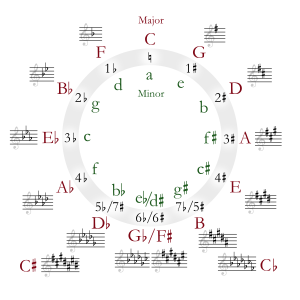Major scale based on C
C major (or the key of C) is a major scale based on C, consisting of the pitches C, D, E, F, G, A, and B. C major is one of the most common keys used in music. Its key signature has no flats or sharps. Its relative minor is A minor and its parallel minor is C minor.
The C major scale is:
On the piano, the C major scale can be played by playing only the white keys starting on C.
Scale degree chords
The scale-degree chords of C major are:
Compositions
Twenty of Joseph Haydn's 106 symphonies are in C major, making it his second most-used key, second to D major. Of the 134 symphonies mistakenly attributed to Haydn that H. C. Robbins Landon lists in his catalog, 33 are in C major, more than any other key. Before the invention of the valves, Haydn did not write trumpet and timpani parts in his symphonies, except those in C major. Landon writes that it wasn't "until 1774 that Haydn uses trumpets and timpani in a key other than C major... and then only sparingly." Most of Haydn's symphonies in C major are labelled "festive" and are of a primarily celebratory mood.[1] Wilfrid Mellers believed that Mozart's Symphony No. 41, written in 'white' C major, "represented the triumph of light".[2] (See also List of symphonies in C major.)
Many masses and settings of the Te Deum in the Classical era were in C major. Mozart and Haydn wrote most of their masses in C major.[3] Gounod (in a review of Sibelius' Third Symphony) said that "only God composes in C major". Six of his own masses are written in C.[4]
Of Franz Schubert's two symphonies in the key, the first is nicknamed the "Little C major" and the second the "Great C major".
Scott Joplin's "The Entertainer" is written in C major.
Many musicians have pointed out that every musical key conjures up specific feelings.[5] This idea is further explored in a radio program called The Signature Series. American popular songwriter Bob Dylan claimed the key of C major to "be the key of strength, but also the key of regret".[6] Sibelius's Symphony No. 7 is in C major and that key was of great importance in his previous symphonies.[7]
Notable examples
- Johann Sebastian Bach
- Joseph Haydn
- Wolfgang Amadeus Mozart
- 12 Variations in C major on the French song "Ah, vous dirai-je, Maman", KV 265
- Concerto for flute and harp, KV 299/297c
- Piano Concerto No. 8, KV 246 ("Lützow")
- Piano Concerto No. 13, KV 415
- Piano Concerto No. 21, KV 467
- Piano Concerto No. 25, KV 503
- Piano Sonata No. 1, KV 279
- Piano Sonata No. 7, KV 309
- Piano Sonata No. 10, KV 330
- Piano Sonata No. 16, KV 545
- String Quartet No. 19, KV 465 ("Dissonance")
- Symphony No. 16, KV 128
- Symphony No. 22, KV 162
- Symphony No. 28, KV 200
- Symphony No. 34, KV 338
- Symphony No. 36, KV 425 ("Linz")
- Symphony No. 41, KV 551 ("Jupiter")
- Ludwig van Beethoven
- Piano Sonata No. 3, Op. 2, No. 3
- Piano Concerto No. 1, Op. 15
- Symphony No. 1, Op. 21
- Rondo Op. 51, No. 1
- Piano Sonata No. 21, Op. 53 ("Waldstein")
- Triple Concerto for violin, cello, and piano in C major, Op. 56
- String Quartet No. 7, Op. 59/1 ("Rasumovsky")
- Mass in C major, Op. 86
- Franz Schubert
- Felix Mendelssohn
- Frédéric Chopin
- Robert Schumann
- Georges Bizet
- Jean Sibelius
- Maurice Ravel: Boléro
- Igor Stravinsky: Symphony in C (1940)
- Sergei Prokofiev
- Dmitri Shostakovich: Symphony No. 7, Op. 60 ("Leningrad")
- Terry Riley: In C
- Duke Ellington: "C Jam Blues"


